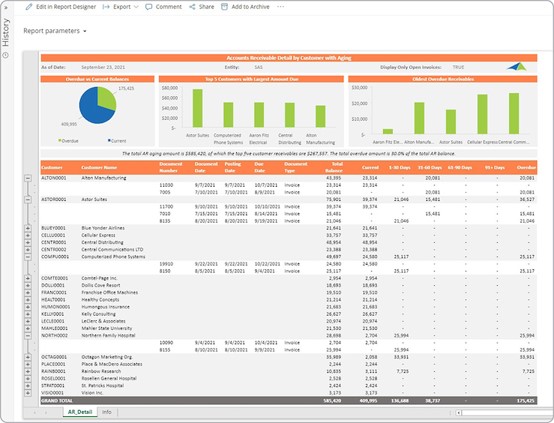Using Accounts Receivable Detail Reports to Streamline the AR Aging Analysis Process
How can
Accounts Receivable Report
s Drive Faster and Better Decisions? As Accounting and Collections Managers increasingly become key innovators in the AR Aging Analysis and Collections Process, they must rely on modern self-service corporate performance management (CPM) and business intelligence (BI) tools. Using interactive Accounts Receivable Reports like the Accounts Receivable (AR) Detail Report template shown below enables them and users from the finance and receivables teams to experience near real time customer AR aging analysis that help drive faster and better decisions.
Who uses
Accounts Receivable (AR) Detail Report
s and What are Some Key Analytical Features? In today’s fast-paced business environment, Accounting and Collections Managers are under high pressure to supply end users like collections staff and accountants with timely and concise Accounts Receivable Reports. Companies use key features like the ones below to support their users with effective analysis that helps drive improved cash flow and AR aging visibility:
- Receivables detail by customer, including invoice numbers, invoice dates, invoice amounts and categorized aging of outstanding invoices
- The detail list in the lower portion of the report has the option to include only open items, closed items, or all items
- Graphical view of total AR balances, Top 5 customers by amount due, and oldest overdue invoices
The Accounts Receivable (AR) Detail Report template can be used as a key element of the AR Aging Analysis process:
 The Accounts Receivable (AR) Detail Report is a ready-to-use AR Report from the
Solver Marketplace.
A Brief Description of the
Accounts Receivable (AR) Detail Report
Template Accounts Receivable Reports like the one seen in the image above are interactive and parameter driven and typically contain sections with Accounts Receivable information in both graphical and list format. One of the important features that aid the user in the analysis process is the ability to view detailed accounts receivable transactions by document number summarized by customer and with grand totals. Accounts Receivable (AR) Detail Reports are often used in conjunction with AR summary reports, sales reports, Accounts Receivable and customer analysis dashboards, balance sheets, and profit & loss variance reports.
Data Integration to Transaction Systems Most organizations these days want automated and streamlined
planning,
reporting and
analysis. However, many of the benefits described earlier rely on best of breed Corporate Performance Management (CPM) tools and/or Business Intelligence (BI) capabilities as well as data marts or data warehouses that use pre-built integrations to the organization’s ERP system. Oftentimes, they also need integrations to other key data sources like CRM, subscription systems, payroll tools, etc. Modern, cloud-based ERPs like Microsoft Dynamics 365 Finance (D365 Finance), Microsoft Dynamics 365 Business Central (D365 BC), Sage Intacct, Acumatica, Netsuite and SAP have robust APIs which allow for dynamic integrations to CPM and BI tools that are fully automated and flexible to run on a schedule or on-demand.
Additional Resources to Aid with Research of Templates, CPM and BI Tools
The Accounts Receivable (AR) Detail Report is a ready-to-use AR Report from the
Solver Marketplace.
A Brief Description of the
Accounts Receivable (AR) Detail Report
Template Accounts Receivable Reports like the one seen in the image above are interactive and parameter driven and typically contain sections with Accounts Receivable information in both graphical and list format. One of the important features that aid the user in the analysis process is the ability to view detailed accounts receivable transactions by document number summarized by customer and with grand totals. Accounts Receivable (AR) Detail Reports are often used in conjunction with AR summary reports, sales reports, Accounts Receivable and customer analysis dashboards, balance sheets, and profit & loss variance reports.
Data Integration to Transaction Systems Most organizations these days want automated and streamlined
planning,
reporting and
analysis. However, many of the benefits described earlier rely on best of breed Corporate Performance Management (CPM) tools and/or Business Intelligence (BI) capabilities as well as data marts or data warehouses that use pre-built integrations to the organization’s ERP system. Oftentimes, they also need integrations to other key data sources like CRM, subscription systems, payroll tools, etc. Modern, cloud-based ERPs like Microsoft Dynamics 365 Finance (D365 Finance), Microsoft Dynamics 365 Business Central (D365 BC), Sage Intacct, Acumatica, Netsuite and SAP have robust APIs which allow for dynamic integrations to CPM and BI tools that are fully automated and flexible to run on a schedule or on-demand.
Additional Resources to Aid with Research of Templates, CPM and BI Tools
- Templates from Solver that are pre-built and that work out-of-the-box using the Solver CPM cloud. Click here.
- Template examples: You find more than 500 CPM and BI Template examples here.
- Interactive Dashboard examples: Try Power BI dashboard templates from Solver here.
- Software evaluation and selection:
- Creating efficient processes:
April 16, 2022
TAGS:
Solver,
Microsoft,
aging,
Acumatica,
customer,
Netsuite,
D365 BC,
GP,
QuickStart,
report templates,
collections,
AR,
ax,
Microsoft Dynamics,
Dynamics 365,
Dynamics 365 Business Central,
Sage Intacct,
dashboard templates,
KPI,
budget templates,
Oracle,
receivables,
dynamics 365 finance,
SAP,
templates,
Sage,
business one,
financial templates,
D365,
NAV,
Intacct,
BI,
CPM,
report,
SL,
dynamics,
EPM,
receivable,
ar aging report,
Accounts Receivable,
invoice,
collections staff and accountants,
AR aging analysis,
AR detail report,
Accounts Receivable (AR) Detail Report,
Accounting and Collections Managers,
Accounts Receivable Report

 The Accounts Receivable (AR) Detail Report is a ready-to-use AR Report from the
The Accounts Receivable (AR) Detail Report is a ready-to-use AR Report from the